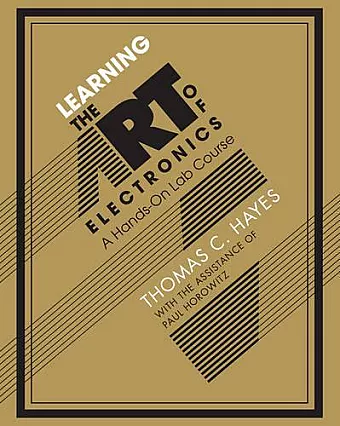Learning the Art of Electronics
A Hands-On Lab Course
Thomas C Hayes author Paul Horowitz author
Format:Paperback
Publisher:Cambridge University Press
Published:2nd Mar '16
Should be back in stock very soon

This pacy introduction to circuits assumes no knowledge of electronics. Students gain understanding by exposure to good design examples.
Turn to this book if you want to learn about different types of circuits and their behavior. You will gain a deep and intuitive understanding of circuit operation, be exposed to advanced circuit designs, and learn to build analog and digital devices from first principles using basic components.This introduction to circuit design is unusual in several respects. First, it offers not just explanations, but a full course. Each of the twenty-five sessions begins with a discussion of a particular sort of circuit followed by the chance to try it out and see how it actually behaves. Accordingly, students understand the circuit's operation in a way that is deeper and much more satisfying than the manipulation of formulas. Second, it describes circuits that more traditional engineering introductions would postpone: on the third day, we build a radio receiver; on the fifth day, we build an operational amplifier from an array of transistors. The digital half of the course centers on applying microcontrollers, but gives exposure to Verilog, a powerful Hardware Description Language. Third, it proceeds at a rapid pace but requires no prior knowledge of electronics. Students gain intuitive understanding through immersion in good circuit design.
'Author Thomas Hayes, … designed the new volume for a full-semester laboratory course. [The book] is organised into 26 chapters, each offering rich context and clear explanations in labs, notes, supplementary material and worked problems … labs are balanced between analog and digital electronics. Hayes begins with familiar analog circuitry and includes discussions of voltage dividers, Ohm's and Kirchoffs's laws, and Thevenin equivalents. The labs tackle RC filters in both time and frequency domains with a cheerful approach that is not overly mathematical … retains many of the handsomely drawn circuits of the original Art of Electronics and is much more comprehensive … Instructors will want to know if Learning the Art of Electronics can stand alone as an undergraduate lab text. The answer is yes. While the book does cross-reference The Art of Electronics, it 'means to be self-sufficient', and it achieves that goal.' Paul J. H. Tjossem, Physics Today
'… a well-paced, self-guided course for anyone (who realistically has completed one year of undergraduate studies prior) wanting to get into electronics.' Kymani Armstrong-Williams, https://physicsbookreviewer.blogspot.com
ISBN: 9780521177238
Dimensions: 255mm x 204mm x 41mm
Weight: 2130g
1150 pages